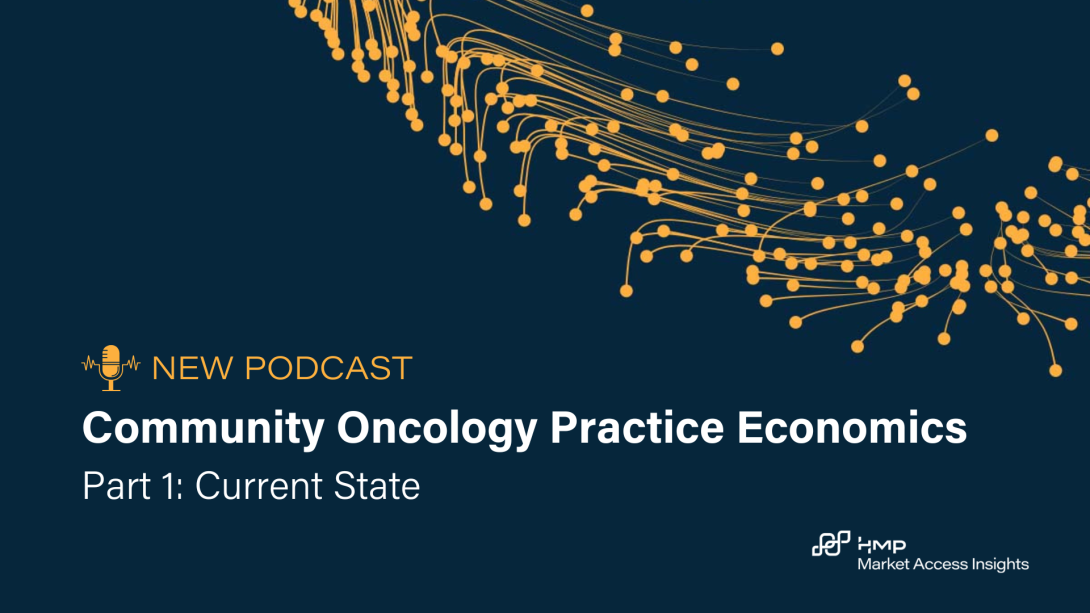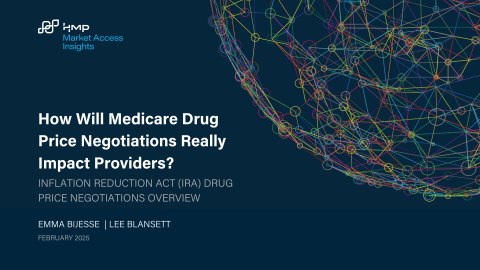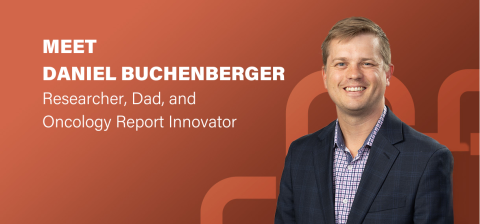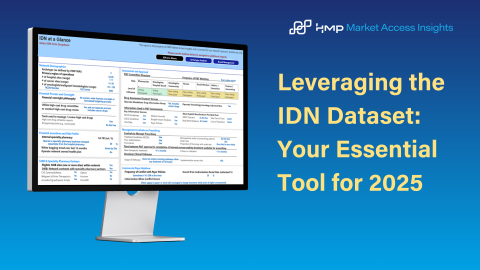

Podcast
Community Oncology Practice Economics - Podcast Part 1 of 3
November 07, 2024Authors
Topics
In part 1 of this 3-part podcast series, HMP Executive Vice President Lee Blansett and special guest John Hennessy—health system, provider and oncology strategist—explore the current state of oncology practice economics.

In this first episode of HMP Market Access Insights' 3-part series on oncology practice economics, Lee Blansett and guest expert John Hennessy dive into the financial landscape of community oncology practices. From drug margins to referral strategies, Lee and John examine the factors that influence how practices sustain themselves and adapt to changing economic pressures. Don't miss this insightful conversation.
Read full transcript:
Ashutosh Sheth: Hello, this is Ashutosh Sheth with HMP Market Access Insights, the leader in the “know-how” and “know-why” in oncology. We would like to welcome you to our Q3 2024 podcast, a 3-part interview between my colleague, Lee Blansett, and special guest, John Hennessy. Together, they will be diving into the world of oncology practice economics, discussing the current state, operational realities, and emerging models of success.
In part 1, Lee and John will be focusing on the current state of oncology practice economics. Please note, this podcast is just 1 piece of the comprehensive 2024 package of oncology market access research assets that our client subscribers receive to gain a deeper understanding of their customers and make better business decisions.
For more information, please visit our website at www.MarketAccessInsights.com. And now, here's Lee and John, kicking off Part 1.
Lee Blansett: Hi, I'm Lee Blansett. I'm here from HMP Market Access Insights, and today I've been joined by an old colleague and friend, John Hennessy.
John Hennessy: Hi, it’s great to be here.
Lee Blansett: Today, John and I are going to be talking about physician practice economics. We still have some active advisory work that we're doing in that space. I know John spends a good part of nearly every day of the week talking to the practice. So, what we're going to discuss today is how doctors are making money, what the sustainability of the model is, and what has changed. We’ve been hearing a lot of doom and gloom over the last few years, but every time we run some numbers, we see things coming up that are not looking all that much different, frankly.
John Hennessy: Yeah. I think doom and gloom is a seasonal event in physician practice. You and I have been doing this for quite some time. I can remember the 1990s and the 2000s, every time there was a new Medicare fee schedule, it was “the end of times.” Yet, somehow, every January 2, we managed to keep the offices open and see patients again. It's never as rosy as you would like. Fee schedules are getting tighter. The federal government's budget is getting tighter. We do have to figure out a way to operate on less and thinking about how that impacts programs on a day-to-day basis, but also longitudinally, is important. We don't have enough people in the oncology world providing care to patients, and practice economics is key to continuing to retain staff and to bring more people into the practices of medicine.
Lee Blansett: We’ve seen, since I started with oncology, that the whole business model is built on drug margin. I laugh sometimes talking with a couple of other old friends about “original sin,” which was when they issued the first fee schedule and they didn't put enough RVUs in chemotherapy administration. They cut a deal with the oncologists to accept drug margin in place of admin dollars.
John Hennessy: I think part of that is the complexity of managing oncology patients and, to your point, that original sin that we grew the business around that model. It's very hard to unring that bell because cancer patients—I don't want to call them “needy”—but they do have lots of needs. It's not simply delivering drug and we're done. There are psychosocial needs. There are food insecurity needs. There are mental health needs. Not all of these needs are easily coordinated with everything else you're doing in oncology. I do think oncology practices take on a lot, but we have to in order to help patients get through this journey, and not just patients, but their caregivers as well.
Lee Blansett: Right. And I think that's where the drugs come in but what's really interesting to me is the first time we ran this analysis, around 2001 to 2002, we were looking at what would happen when they switched from average wholesale price (AWP) to average sales price (ASP).
John Hennessy: And it was “the end of times,” as you'll recall.
Lee Blansett: Even CMS admitted that they'd been underpaying because they increased the admin fee by 245% for a year and then started ramping it down. John Hennessy: It was a challenging time, transitionally. I remember “end-of-times” mathematics being done. But, like many things, you managed to survive. I worked in a workers’ comp for a while and one of my friends was in government relations. He once said, “Tell me what the rules are going to be, and I'll figure it out.” That’s what we've seen in oncology.
Lee Blansett: I think we have. So, we're looking here at a model we built a couple years ago, the last year American Society of Clinical Oncology (ASCO) published practice economic data. We had to fill in some holes from one of our probono clients, but what we see here is that the model continues to be built nearly entirely upon drug margin and drug revenue.
John Hennessy: I think that's true, and particularly if you're looking at a medical oncology-only practice. There are practices who've been able to diversify by adding radiation oncology, surgical oncology, maybe more those who are in the ASC spaces. Some folks have been able to bring in imaging and have that provide balance. But even in the most diverse practices, drug revenue and cost-to-charge ratio or the cost-to-revenue ratio is still the vital fluid. It's the aorta of the practice. And even though the aorta has narrowed a little bit, that’s still what it is.
Lee Blansett: When you speak about narrowing blood flow, you can see here what the net margin was per doctor in our estimate, around $400 000 a year, and this was in 2023. The first year I was in this, in 2001, I remember even ASCO admitted the average revenue for a doctor in medical oncology was around $750 000. So we have seen a substantial decline in earnings.
John Hennessy: I think so. We have a set of groups within PracticeNet, I don't know how unique it is or not, but I think maybe the larger practices have different economics than smaller ones, certainly. There are hospital-based practices in here. We do know there is cross subsidization between service lines within hospitals. But, generally speaking, I think the best way to know what the margin is per physician is looking at starting salaries for recruiting folks, and if community practices couldn't make that work, you wouldn't see them recruiting new patients. I know, at least from the big practices, if you're on LinkedIn, as we both are, they're always announcing new doctors starting in some place. So somehow they're able to afford these new salaries, or find a way to make that work within the economic structure.
Lee Blansett: But I think what we're seeing is the larger groups that are doing that recruiting. It's not the low 2- and 3-doctor groups any longer.
John Hennessy: That is a real concern. I know, from a rural medicine standpoint, it's a massive challenge to try to make that happen. In gynecologic oncology, we've seen the concentration of those physicians in urban settings in large part because of things like that. In the urban settings, you can possibly generate a little more margin. You have a little more of an ability to get more out of the managed care companies. There is some redistribution of resources that is created by these economics that make it hard for the smaller practices to bring those folks in. We’ve had a lot of chances to visit practices in my volunteer work with ASCO, everything from 80-doctor hospital service lines, down to single practitioners, and the single practitioners really struggle to bring that second person on and there are a lot of operational issues there, but the economics is part of it. If you're making $10 and, to bring another guy on, you have to split that with him. Then you're both making $5. That's really tough to do unless there is some way to get it back to $10 really fast, and that doesn't exist anymore.
Lee Blansett: No, what we have seen though, to your point, is there have been evolutions of the model. The first time we did this model 20 years ago, we didn't have oral drugs in it. Now we see orals as being a core part of the business, not only in terms of patient care, but also economically. Margins are still holding up there. We know there was a lot of noise and, I think, justifiable anger at some of the new PBMV schedules this year. Regardless, what's been interesting is, in our survey this year with community groups, we saw a flattening of the volume of oral drugs being dispensed, but we saw only a couple of cases where the groups were actually pulling out of dispensing completely. Mainly, what we heard was that they’re being more thoughtful about which payers they dispense for. They're thinking which brands they dispense, and particularly brands. We heard a lot of talk around, “We'll dispense brand A, but we're not going to dispense brand B, because our deal with the GPO doesn't let us break even on brand B."
John Hennessy: Yeah, it's an interesting challenge, and I'll say that in running a practice, you tend to try to participate in every payer that you logistically can, and you try to make sure you offer all the infused services that you can, largely because you don't want your referring physician base to have to go someplace else for anything. I might do things that are relatively expensive as opposed to letting the academic center do it because I don't want my referring physicians to think they have to go there. The same would be true about infusion products, or maybe a health plan that doesn't reimburse all that well, but I want to make sure that, again, my referring physicians know to send me everything. That’s why in our practice years ago, we took care of uninsured patients. We took care of patients who otherwise didn't have resources, just to make sure that the other 95% of the referrals stayed with me. I think with the orals, it's a little bit different case, because you're not necessarily shipping that volume off to the University of X. It's going to an Express Scripts or someone else like that. So it's a little easier to make the decision that I won't carry this particular product or that particular product. The other thing that makes that complex are the copay accumulators, the maximizers, alternative funding programs, which make those economic decisions a little bit more challenging. Fast start programs sound great, but if you're still struggling 3 and 4 weeks out to get that first prior authorization, those gaps can be really challenging. So I don't see practices abandoning this anytime soon, but it's not surprising that they are refining their techniques, finding where their lane is, growing their lane where they're doing well, and maybe narrowing it in other places.
Ashutosh Sheth: Thank you all for listening. This concludes Part 1 of this 3-part podcast by HMP Market Access Insights on Oncology Practice Economics. In Part 2, Lee and John will explore the operational realities of oncology practices.
The Latest
Article
Thought Leadership Whitepaper: How Will Medicare Drug Price Negotiations Really Impact Providers?
As manufacturers prepare for Medicare drug price negotiations, a critical question emerges: How will your provider engagement strategy evolve when Maximum Fair Prices (MFP) take effect in 2026?
Emma BijesseArticle
Meet Dan: Researcher, Dad, and Oncology Report Innovator
At HMP Market Access Insights, we’re lucky to have a team of experts dedicated to uncovering meaningful insights in the oncology space. One of those experts is Dan, whose work is shaping how we approach community oncology research.
Daniel BuchenbergerArticle
Leveraging the IDN Dataset: Your Essential Tool for 2025
As IDNs face increasing complexity in oncology management, having a strategic approach backed by actionable insights is critical. Our dataset doesn’t just offer data—it equips your teams with the tools to anticipate challenges and seize opportunities.
Emma Bijesse





